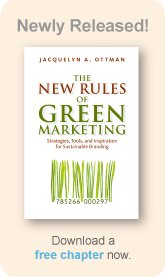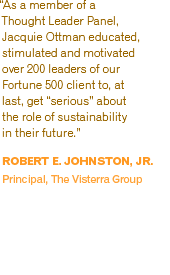Empower to the People
By Jacquelyn A. Ottman
In Business, January 2004
The most successful brands on earth connect with their consumers emotionally in addition to logical facts and rational appeals. Effective green product marketers connect with the concerned and aware consumers willing to pay a premium to buy green products by empowering them to clean the air, purify the water, or help save endangered forests and species. It's the reason why consumers buy green products in the first place.
Product purchasing and consumption are the #1 ways in which Americans act upon their environmental worries. Ask an American adult what he/she is doing to save the planet and their responses most likely will center on product-related behaviors like turning off the lights when leaving a room, recycling products and packages (and more recycling), and looking for green labels when shopping. These activities are more prevalent than donating to environmental groups or voting for green candidates, for instance.
So showing consumers how products will help them address environmental issues is a key quiver in a green marketer's arsenal.
EDUCATE
According to Roper's Green Gauge, 50% of American adults say they would do more for the environment if only they knew how. So, education is critical. Does your product save water or energy? Does it help cut down on waste that must be landfilled? Does it contain fewer toxics that can harm children or wildlife? Let your customers know this!
Better yet, dramatize just how much of an impact your customer can have either by him/herself or in concert with scores of other consumers also using your product. As one good example, advertsing for Wellman's EcoSpun fiber made from 100% recycled soda bottles claimed that the fiber production, "Saved enough energy to power a city the size of Atlanta for a year."
How much energy, water does your product save? Aggregating environmental benefits across a the broad swath of possible consumers and/or across time, if credible, and verifiable by a third party, can help consumers feel as if they are really making a difference. This will help project a deep green image on your brand and company, and generate the loyalty that builds brands over time.
PERSONALIZE
What environmental issues are your own customers most concerned about? What environmental issues do your product address best? Enhance relevance and build credibility by focusing on them. Stonyfield Farm, the makers of high quality and organic yogurts capitalizes on consumers concerns for global warming - and the link between methane produced by dairy cows, to help empower consumers to take action. The company has engaged in energy efficiency programs to reduce the gases produced at power plants, and invested in reforestation efforts to help offset their own carbon emissions. Then, to promote global warming awareness to its customers, it distributed five million yogurt container lids urging consumers to "Put a Lid on Global Warming." Inside the lids was information and a website with more information.
BE UPBEAT
Environmental matters are serious indeed, and if you let them, they will drag down your brand's image, limiting your acceptance among a wide range of consumers. That's why there's a big opportunity to make your brand stand for hope. Project optimism. Make it fun to do the right thing.
One of my favorite green marketing slogans come from the makers of GreenDisk brand diskettes that are recovered from unsold boxes of software. Recognizing the superior quality of diskettes that survive the thrice-inspected trip to retail store shelves, packaging for GreenDisks brags,"Made from the best diskettes everyone else ever made."
BRING IT HOME
Of all the strategies for empowering consumers, perhaps the most effective is this one. Focus on the local. There's a raft of issues that concern consumers but they can't do anything about - global warming, ozone layer depletion, rainforest destruction, and the like. And there's a host of issues that are purely local in nature - litter, graffiti, sprawl, you know them well
When possible, demonstrate how your product or company can affect change locally. Or demonstrate how your product's use can actually help address issues that sound faraway or are out of one's personal control. Labels and farmer's markets that help consumers understand how produce was farmed locally is a great example. So are products that can be verifiably sourced from the rain forest.



 ShareThis
ShareThis
Jacquelyn Ottman is president of J. Ottman Consulting, Inc., a New York-based marketing consulting firm that specializes in helping businesses derive competitive advantage from eco-innovation and green marketing. She is the author of Green Marketing: Opportunity for Innovation, 2nd edition.
Contact Us to learn more about J. Ottman's green marketing services.
Follow Jacquie on Twitter
Read Jacquie Ottman's Green Marketing Blog
Copyright© 2008 by J. Ottman Consulting, Inc.


